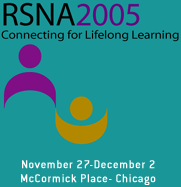
Abstract Archives of the RSNA, 2005
Arthur Hung MD, Presenter: Nothing to Disclose
Luciana Peclat de Paula MD, Abstract Co-Author: Nothing to Disclose
Darryl Kaurin PhD, Abstract Co-Author: Nothing to Disclose
Mark Garzotto MD, Abstract Co-Author: Nothing to Disclose
Purpose/Objective: A rectal balloon (RB) has been reported to decrease the amount of rectal wall within the high-dose regions by posteriorly displaying the posterior half of the rectum. We have observed patients with thick rectovesical septums, Denonvilliers fascia (DF), actually experiencing anterior displacement by the RB of the anterior rectal wall against the posterior surface of the prostate. The goal of this study was to evaluate the dosimetric effect of using the RB and whether specific anatomic factors were predictive. Materials/Methods: 10 consecutive patients underwent CT simulation for treatment of their prostate cancer. The patients were imaged without and with the RB. Comparisons were made based on the assumption that the rectal wall volume with and without the RB is equal. The rectal wall thickness was estimated at 5 mm for patients without the balloon and 3 mm for patients with. The absolute rectal wall volumes were within 3% agreement between the balloon and no balloon plans with this methodology. Three different treatment techniques were considered: 7field IMRT to the prostate only, 7field IMRT to the prostate and seminal vesicles, 7field 3-D conformal to the prostate and seminal vesicles. Thus 6 plans were generated for each patient, 3 with and 3 without the RB, for a total of 60 plans. The same dose specifications were used for all plans. The PTV consisted of prostate or prostate and seminal vesicles expanded by 1.2 cm margin in all dimensions except posteriorly where the expansion was 7 mm. The prostate dose was specified to 75.6 Gy and the seminal vesicle dose was 60 Gy. The objectives were to cover the PTV by 95% while maintaining 20% of the rectum below 70 Gy. The factors examined included the volumes of the prostate and seminal vesicles, the thickness of DF at the apex, middle of the prostate; base, and middle of the seminal vesicles. The dose levels evaluated were at 50, 60, 70, 72, 75, and 80 Gy for every plan. Results: Without the RB, the median DF thickness was 9 mm (5-16) at the apex, 25 mm (17-44) at the base, and 27 mm (9-39) at the midpoint of the seminal vesicles (mid-SV). With the RB, the corresponding measurements were 4 mm (2-5), 11.5 mm (2-18), and 6 mm (4-13). As we expected, there was a lot of variation in whether and how the patients benefited from the RB depending on the treatment technique and the dose level evaluated. Because our rectal wall volume was normalized, we could perform a direct comparison between the plans with and without the RB. At low doses (50 Gy), treatment plans with the RB exposed less of the rectum by 2-7% over their non-balloon counterpart. However at higher doses (70 Gy) when targeting the prostate alone, the RB did not have an overall effect on the group of 10 patients. Individually, 5 patients benefited from the balloon and 5 patients did not. But when including the seminal vesicles in the target volume, the RB actually increased the amount of rectal wall exposed above 70 Gy by 1 to 10% except in 2 patients. Evaluating the amount of rectal wall exposed above 75 Gy found that the RB exposed 0 to 9% more of the rectum than the patients treated without the RB except in 1 patient. We performed Spearmans correlation tests on our measurements of DF and identified the measurement of DF at the mid-SV to be the most predictive of higher rectal doses when including the seminal vesicles in the treatment plan. We were unable to identify an anatomic measurement that would predict whether a patient would benefit from the RB or not. Conclusions: The DF can be compressed by the RB resulting in a closer juxtaposition of the anterior wall of the rectum to the prostate. The RB slightly increased the percentage of rectum receiving higher doses of radiation regardless of the treatment technique.
Hung, A,
de Paula, L,
Kaurin, D,
Garzotto, M,
Questionable Dosimetric Benefit of the Rectal Balloon. Radiological Society of North America 2005 Scientific Assembly and Annual Meeting, November 27 - December 2, 2005 ,Chicago IL.
http://archive.rsna.org/2005/4420817.html

